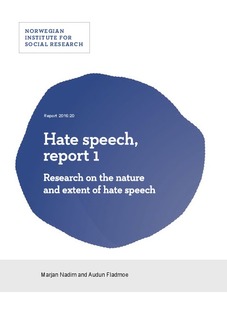| dc.contributor.author | Nadim, Marjan | |
| dc.contributor.author | Fladmoe, Audun | |
| dc.date.accessioned | 2017-05-16T06:14:26Z | |
| dc.date.available | 2017-05-16T06:14:26Z | |
| dc.date.created | 2017-01-10T09:18:46Z | |
| dc.date.issued | 2016 | |
| dc.identifier.isbn | 978-82-7763-539-2 | |
| dc.identifier.uri | http://hdl.handle.net/11250/2442521 | |
| dc.description.abstract | The purpose of this report is to gather research-based knowledge concerning: • the extent of online hate speech • which groups in society are particularly subjected to online hate speech • who produces hate speech, and what motivates them Hate speech is commonly understood as any speech that is persecutory, degrading or discriminatory on grounds of the recipient’s minority group identity. To be defined as hate speech, the speech must be conveyed publicly or in the presence of others and be directed at a certain group or an individual’s (assumed) group identity. The concept pertains notably to particularly vulnerable minority groups. Section 185 of the Norwegian Penal Code provides legal protection against discrimination or hate speech on grounds of: a) skin colour or national or ethnic origin, b) religion or life stance, c) homosexual orientation or d) disability. The concept of “hate speech” is, however, often used in a broader sense than what ensues from the Norwegian Penal Code. The present report discusses research that concerns both criminal and non-criminal hate speech, as well as other offensive statements or displays that might be perceived as hate speech. The report demonstrates that statistics on officially reported instances of alleged criminal hate speech are extremely limited and not adequate for determining the extent of hate speech. Various questionnaire-based surveys serve to fill out the picture, but one of the problems of this type of research is that very few studies have investigated the extent of hate speech directly. Different studies have applied different definitions of hate speech and other offensive statements and hence arrived at greatly differing figures for the extent. Many of the studies have primarily addressed online hate more generally, without reference to the concept of “hate speech”. This means that there are few studies that examine hate speech aimed at specific group identities. Regardless of how the prevailing terms have been defined in the empirical studies, our systematic review shows that ethnicity and sexual orientation are the commonest grounds for hate speech. Less research has been conducted on online hate targeting disability. Furthermore, young people are far more often subjected to offensive experiences online than others. Overall, gender differences are relatively insignificant when it comes to exposure, but women and men are subjected to different forms of online hate. | |
| dc.language.iso | eng | |
| dc.publisher | Institutt for samfunnsforskning | |
| dc.relation.ispartof | Rapport - Institutt for samfunnsforskning | |
| dc.relation.ispartofseries | Rapport - Institutt for samfunnsforskning | |
| dc.subject | Nettmobbing | |
| dc.subject | Online bullying | |
| dc.subject | Internett | |
| dc.subject | Internet | |
| dc.subject | Hatefulle ytringer | |
| dc.subject | Hate speech | |
| dc.title | Hate speech, report 1. Research on the nature and extent of hate speech | |
| dc.type | Research report | |
| dc.description.version | publishedVersion | |
| dc.subject.nsi | VDP::Sosiologi: 220 | |
| dc.subject.nsi | VDP::Sociology: 220 | |
| dc.source.pagenumber | 56 | |
| dc.source.issue | 2016:20 | |
| dc.identifier.cristin | 1423866 | |
| dc.relation.project | Barne-, ungdoms og familiedirektoratet (Bufdir): 10168 | |
| cristin.unitcode | 7437,0,0,0 | |
| cristin.unitname | Institutt for samfunnsforskning | |
| cristin.ispublished | true | |
| cristin.fulltext | original | |
